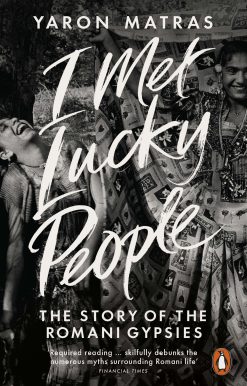The Negroni: Drinking to La Dolce Vita, with Recipes & Lore [A Cocktail Recipe Book]
| by |
|---|
16.00 JOD
Please allow 2 – 5 weeks for delivery of this item
Description
A history of one of the world’s most iconic cocktails—originally an Italian aperitivo, but now a staple of craft bar programs everywhere—with 60 recipes for variations and contemporary updates. The Negroni is one of the simplest and most elegant drink formulas around: combine one part gin, one part sweet vermouth, and one part Campari, then stir and serve over ice. This bitter, sweet, and smooth drink has inspired countless variations as well as legions of diehard aficionados. In The Negroni, Gary Regan—barman extraordinaire and author of the iconic book The Joy of Mixology—delves into the drink’s fun, fascinating history (its origin story is still debated, with battling Italian noblemen laying claim) and provides techniques for modern updates (barrel aging and carbonation among them). Sixty delightfully varied and uniformly tasty recipes round out this spirited collection, which is a must-have for any true cocktail enthusiast.
Additional information
| Weight | 0.45 kg |
|---|---|
| Dimensions | 2.04 × 14.79 × 21.01 cm |
| by | |
| Format | Hardback |
| Language | |
| Pages | 176 |
| Publisher | |
| Year Published | 2015-5-5 |
| Imprint | |
| Publication City/Country | USA |
| ISBN 10 | 1607747790 |
| About The Author | GARY REGAN writes The Cocktailian, a biweekly column for the San Francisco Chronicle. His work has been featured in magazines such as Food Arts, Food & Wine, Wine & Spirits, and Imbibe, among others. He is the author of The Bartender's Bible, The Book of Bourbon and Other Fine American Whiskey, The Bourbon Companion, New Classic Cocktails, The Martini Companion, and The Joy of Mixology. |
"Gary Regan, an expert on drinks, explores the cocktail with recipes, classic and new, and shows how easy it is to experiment."– Florence Fabricant, The New York Times"It's hard to imagine a 150-page book devoted to a single cocktail — until you realize how many stories there are to tell about the Negroni. . . Regan is just the man to tell these stories."– Chicago Tribune "A former bartender and prolific author, Regan has uncovered a wealth of lore surrounding the Negroni, and has assempled a collection of historical recipes that explore the identity of the drink through its many permutations."– Wine & Spirits |
|
| Table Of Content | recipe list Foreword: Perfection Knows Its Place, by Robert Simonson Acknowledgments Introduction PART ONE : THE LORE The One and Only Count Negroni Campari, Negroni’s Muse PART TWO: THE RECIPES The Classic Negronis The New Negronis The Large-Format Negronis The Edible Negronis Credits and Thanks Index |
| Excerpt From Book | INTRODUCTIONThe crowning glory of Campari-based mixed drinks must be the Negroni. Made with equal parts gin, sweet vermouth, and Campari, the Negroni is traditionally served on the rocks with a slice of orange. So, at what point in a meal do I order my Negroni? Whenever I darned well feel like it. That’s when. Sometimes it serves as my digestivo, sometimes it’s my apéritif, and sometimes I order a Negroni when I have no plans to dine at all. It’s a robust cocktail that’s not as strong as, say, a martini, but it lets you know that you’ve had something substantial to drink. —Gary Regan It may seem odd to start this book with an epigraph written by . . . me. The quotation above is from a piece I wrote for Los Angeles magazine in September 2001. Yes, you read that right, 2001—well before the craft cocktail craze, let alone the Negroni craze, that is currently sweeping the country was in full swing. The title of my article was “Italian Sophistication: Bitter Is Better,” and I feel even more strongly about that assertion now than I did nearly fifteen years ago. I honestly don’t remember my first Negroni, but I know that the Milanese theory that one must drink Campari three times before starting to like it certainly never applied to me. Campari was a love-at-first-sip sort of thing for me. I’ve a passion for all things bitter—save for the odd ex-girlfriend. The incredible aspect of the Negroni that not everyone understands—or agrees with—is that it works every time, no matter what brand of gin or sweet vermouth you use. And you can slap my wrist and call me Deborah if it doesn’t also work no matter what ratios you use. Seriously, try it. Go up on the gin, the Campari, or the vermouth. These three ingredients are soul mates, and they support each other no matter how you try to fool them. Personally, I go for a long-on-the-gin Negroni, and when I build them at home, which is very frequently, especially during the warmer months, I tend toward around four parts gin to one part each of sweet vermouth and Campari. I came up with this formula in 1999 for the very first issue of my Ardent Spirits email newsletter, which was published in February, just in time for Valentine’s Day. Originally I called the drink the Valentino, but I soon gave that up. It’s just a damned strong Negroni—the way I like ’em. There are people who will argue that unless the drink is made with equal parts of the trinity that tumbles into the glass and unifies as a Negroni, it cannot be called a Negroni. I’ll fight to the death for their right to say that, but they’re wrong. First, I need to point out that there is no regulatory board governing the names of drinks. And next, I should say that I believe we’d do ourselves a service by looking toward the world of food for guidance in this matter. After all, both chefs and bartenders are in the business of following or creating recipes, right? If a chef makes a béarnaise sauce, do you think he or she first finds out how Jules Colette, the chef who created the sauce Paris in the 1800s, made his béarnaise? No, of course not. And neither do chefs go running to the library to find out the exact recipe for lobster thermidor as it was prepared at Marie’s, the restaurant where the dish originated—again in Paris—to honor Victorien Sardou’s play Thermidor. I think it’s important, whenever possible, to find out how specific cocktails were originally made. And in the case of the Negroni, we’re lucky to have the 1:1:1 formula as a template. But each and every bartender out there, I think, enjoys putting his or her own twist on all of the classics, so let’s not get bogged down in minutiae. Don’t you love going to Tommy’s for a margarita because they make their very own version of the drink there? And it’s still a margarita, right? And for those folk who still insist that the original formula is the only way to go, I applaud your stubbornness—and hope you’ve managed to locate the same brands of gin and vermouth as Count Negroni used back in 1919 . . . For this book, I’ve traveled far and wide to ferret out the absolute best Negroni recipes—variations, riffs, abominations, whatever you want to call them—in the world. Some are pretty darned close to the gin-vermouth-Campari version we’re all familiar with. Others swap in unusual and unexpected modifiers, base spirits, and amari. Some look and feel like a classic Negroni but reveal themselves to be strikingly different upon first sip. Others aren’t even red. (“A white Negroni?” you say, aghast.) What these drinks have in common is their complete and utter deliciousness. And they all owe their existence to the same forefather; they were all built on the same foundation. That foundation is the Negroni, born in Italy (we think), under circumstances that are still fiercely debated to this day, and which I will try to outline for you in the pages that follow.———————————————–East India Negroni Jim Meehan, PDT, New York City According to Jim, “Lustau’s East India Solera sherry is similar in style to the fortified wine that botanist Joseph Banks might have stocked when he sailed with Captain James Cook, the British explorer, in the late 1700s, and it’s a great stand-in for sweet vermouth in this sugarcane-based variation on the classic gin drink.” 2 ounces Banks 5-Island rum 3⁄4 ounce Lustau East India Solera sherry 3⁄4 ounce Campari Garnish: 1 orange twist Stir all the ingredients with ice in a mixing glass, then strain into a rocks glass over 1 large ice cube. Garnish with the orange twist. |
Only logged in customers who have purchased this product may leave a review.
Related products
-
Low stock
20.00 JOD -
On backorder 2-5 Weeks to Arrive
9.99 JOD -
On backorder 2-5 Weeks to Arrive
10.99 JOD -
On backorder 2-5 Weeks to Arrive
9.99 JOD





Reviews
There are no reviews yet.